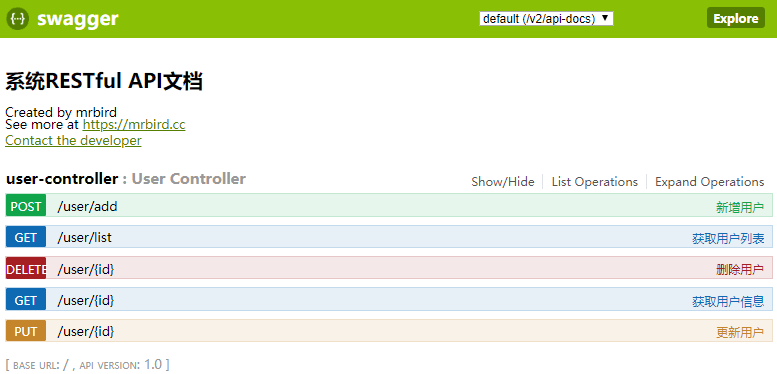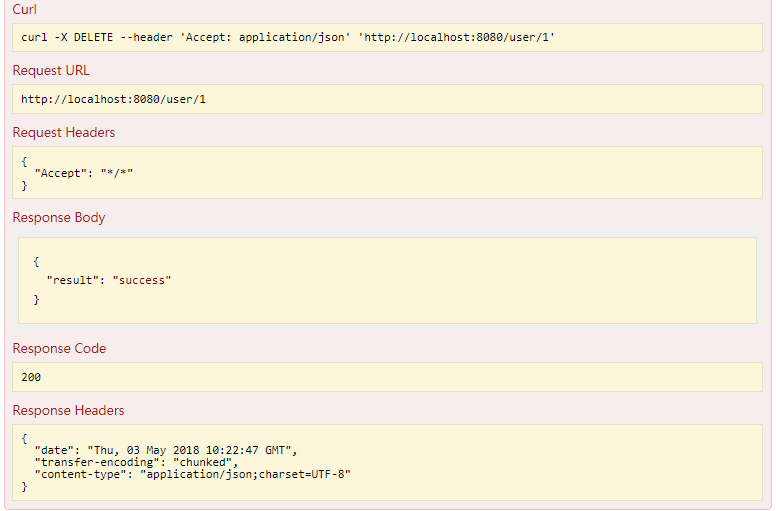Swagger是一款可以快速生成符合RESTful风格API并进行在线调试的插件。本文将介绍如何在Spring Boot中整合Swagger。
在此之前,我们先聊聊什么是REST。REST实际上为Representational State Transfer的缩写,翻译为“表现层状态转化” 。如果一个架构符合REST 原则,就称它为RESTful架构。
实际上,“表现层状态转化”省略了主语,完整的说应该是“资源表现层状态转化”。什么是资源(Resource)?资源指的是网络中信息的表现形式,比如一段文本,一首歌,一个视频文件等等;什么是表现层(Reresentational)?表现层即资源的展现在你面前的形式,比如文本可以是JSON格式的,也可以是XML形式的,甚至为二进制形式的。图片可以是gif,也可以是PNG;什么是状态转换(State Transfer)?用户可使用URL通过HTTP协议来获取各种资源,HTTP协议包含了一些操作资源的方法,比如:GET 用来获取资源, POST 用来新建资源 , PUT 用来更新资源, DELETE 用来删除资源, PATCH 用来更新资源的部分属性。通过这些HTTP协议的方法来操作资源的过程即为状态转换。
下面对比下传统URL请求和RESTful风格请求的区别:
| 描述 | 传统请求 | 方法 | RESTful请求 | 方法 |
|---|---|---|---|---|
| 查询 | /user/query?name=mrbird | GET | /user?name=mrbird | GET |
| 详情 | /user/getInfo?id=1 | GET | /user/1 | GET |
| 创建 | /user/create?name=mrbird | POST | /user | POST |
| 修改 | /user/update?name=mrbird&id=1 | POST | /user/1 | PUT |
| 删除 | /user/delete?id=1 | GET | /user/1 | DELETE |
从上面这张表,我们大致可以总结下传统请求和RESTful请求的几个区别:
- 传统请求通过URL来描述行为,如create,delete等;RESTful请求通过URL来描述资源。
- RESTful请求通过HTTP请求的方法来描述行为,比如DELETE,POST,PUT等,并且使用HTTP状态码来表示不同的结果。
- RESTful请求通过JSON来交换数据。
RESTful只是一种风格,并不是一种强制性的标准。
引入Swagger依赖
本文使用的Swagger版本为2.6.1:
<dependency><groupId>io.springfox</groupId><artifactId>springfox-swagger2</artifactId><version>2.6.1</version></dependency><dependency><groupId>io.springfox</groupId><artifactId>springfox-swagger-ui</artifactId><version>2.6.1</version></dependency>
配置SwaggerConfig
使用JavaConfig的形式配置Swagger:
import org.springframework.context.annotation.Bean;import org.springframework.context.annotation.Configuration;import springfox.documentation.builders.ApiInfoBuilder;import springfox.documentation.builders.PathSelectors;import springfox.documentation.builders.RequestHandlerSelectors;import springfox.documentation.service.ApiInfo;import springfox.documentation.service.Contact;import springfox.documentation.spi.DocumentationType;import springfox.documentation.spring.web.plugins.Docket;import springfox.documentation.swagger2.annotations.EnableSwagger2;@Configuration@EnableSwagger2public class SwaggerConfig {@Beanpublic Docket buildDocket() {return new Docket(DocumentationType.SWAGGER_2).apiInfo(buildApiInf()).select().apis(RequestHandlerSelectors.basePackage("com.example.demo.controller")).paths(PathSelectors.any()).build();}private ApiInfo buildApiInf() {return new ApiInfoBuilder().title("系统RESTful API文档").contact(new Contact("mrbird", "https://mrbird.cc", "852252810@qq.com")).version("1.0").build();}}
在配置类中添加@EnableSwagger2注解来启用Swagger2,apis()定义了扫描的包路径。配置较为简单,其他不做过多说明。
Swagger常用注解
@Api:修饰整个类,描述Controller的作用;@ApiOperation:描述一个类的一个方法,或者说一个接口;@ApiParam:单个参数描述;@ApiModel:用对象来接收参数;@ApiProperty:用对象接收参数时,描述对象的一个字段;@ApiResponse:HTTP响应其中1个描述;@ApiResponses:HTTP响应整体描述;@ApiIgnore:使用该注解忽略这个API;@ApiError:发生错误返回的信息;@ApiImplicitParam:一个请求参数;@ApiImplicitParams:多个请求参数。
编写RESTful API接口
Spring Boot中包含了一些注解,对应于HTTP协议中的方法:
@GetMapping对应HTTP中的GET方法;@PostMapping对应HTTP中的POST方法;@PutMapping对应HTTP中的PUT方法;@DeleteMapping对应HTTP中的DELETE方法;@PatchMapping对应HTTP中的PATCH方法。
我们使用这些注解来编写一个RESTful测试Controller:
import java.util.ArrayList;import java.util.HashMap;import java.util.List;import java.util.Map;import org.springframework.stereotype.Controller;import org.springframework.web.bind.annotation.DeleteMapping;import org.springframework.web.bind.annotation.GetMapping;import org.springframework.web.bind.annotation.PathVariable;import org.springframework.web.bind.annotation.PostMapping;import org.springframework.web.bind.annotation.PutMapping;import org.springframework.web.bind.annotation.RequestBody;import org.springframework.web.bind.annotation.RequestMapping;import org.springframework.web.bind.annotation.ResponseBody;import com.example.demo.domain.User;import io.swagger.annotations.Api;import io.swagger.annotations.ApiImplicitParam;import io.swagger.annotations.ApiImplicitParams;import io.swagger.annotations.ApiOperation;import springfox.documentation.annotations.ApiIgnore;@Api(value = "用户Controller")@Controller@RequestMapping("user")public class UserController {@ApiIgnore@GetMapping("hello")public @ResponseBody String hello() {return "hello";}@ApiOperation(value = "获取用户信息", notes = "根据用户id获取用户信息")@ApiImplicitParam(name = "id", value = "用户id", required = true, dataType = "Long", paramType = "path")@GetMapping("/{id}")public @ResponseBody User getUserById(@PathVariable(value = "id") Long id) {User user = new User();user.setId(id);user.setName("mrbird");user.setAge(25);return user;}@ApiOperation(value = "获取用户列表", notes = "获取用户列表")@GetMapping("/list")public @ResponseBody List<User> getUserList() {List<User> list = new ArrayList<>();User user1 = new User();user1.setId(1l);user1.setName("mrbird");user1.setAge(25);list.add(user1);User user2 = new User();user2.setId(2l);user2.setName("scott");user2.setAge(29);list.add(user2);return list;}@ApiOperation(value = "新增用户", notes = "根据用户实体创建用户")@ApiImplicitParam(name = "user", value = "用户实体", required = true, dataType = "User")@PostMapping("/add")public @ResponseBody Map<String, Object> addUser(@RequestBody User user) {Map<String, Object> map = new HashMap<>();map.put("result", "success");return map;}@ApiOperation(value = "删除用户", notes = "根据用户id删除用户")@ApiImplicitParam(name = "id", value = "用户id", required = true, dataType = "Long", paramType = "path")@DeleteMapping("/{id}")public @ResponseBody Map<String, Object> deleteUser(@PathVariable(value = "id") Long id) {Map<String, Object> map = new HashMap<>();map.put("result", "success");return map;}@ApiOperation(value = "更新用户", notes = "根据用户id更新用户")@ApiImplicitParams({@ApiImplicitParam(name = "id", value = "用户id", required = true, dataType = "Long", paramType = "path"),@ApiImplicitParam(name = "user", value = "用户实体", required = true, dataType = "User") })@PutMapping("/{id}")public @ResponseBody Map<String, Object> updateUser(@PathVariable(value = "id") Long id, @RequestBody User user) {Map<String, Object> map = new HashMap<>();map.put("result", "success");return map;}}
对于不需要生成API的方法或者类,只需要在上面添加@ApiIgnore注解即可。
启动&测试
启动项目,访问http://localhost:8080/swagger-ui.html即可看到Swagger给我们生成的API页面:

点击接口下的“Try it out”Swagger会用curl命令发送请求,并且返回响应信息,如下所示:


